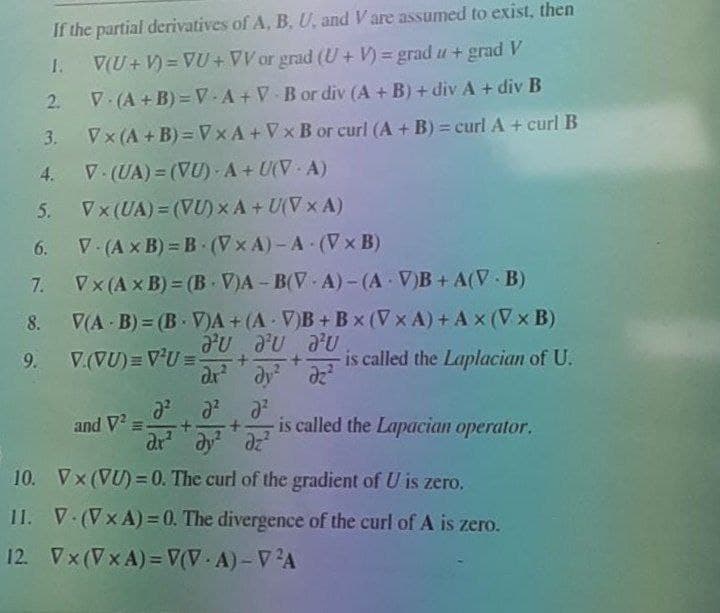If the partial derivatives of A, B. U, and V are assumed to exist, then 1. V(U + V) = VU +V or grad (U+ V)3 grad u+ grad V 2. V (A+B)= V-A+V B or div (A + B) + div A + div B 3. Vx (A + B) = VxA+VxB or curl (A + B) = curlA+ curl B 4. V.(UA) = (VU) - A+ U(V A) Vx (UA) = (VU) x A +U(V x A) V (A x B) = B (Vx A)-A (Vx B) 5. 6. 7. Vx (A x B) = (B V)A- B(V A)-(A V)B+ A(V B) 8. V(A B) = (B V)A + (A V)B +B x (Vx A) + Ax (Vx B) 9. V.(VU)= VU = is called the Laplacian of U. ar dyz and V2 ar ay dz -is called the Lapacian operator. 0. Vx (VU)=0. The curl of the gradient of U is zero. 1. V.(Vx A) = 0. The divergence of the curl of A is zero. 2 Vx (Vx A) = V(V.A)-V A
If the partial derivatives of A, B. U, and V are assumed to exist, then 1. V(U + V) = VU +V or grad (U+ V)3 grad u+ grad V 2. V (A+B)= V-A+V B or div (A + B) + div A + div B 3. Vx (A + B) = VxA+VxB or curl (A + B) = curlA+ curl B 4. V.(UA) = (VU) - A+ U(V A) Vx (UA) = (VU) x A +U(V x A) V (A x B) = B (Vx A)-A (Vx B) 5. 6. 7. Vx (A x B) = (B V)A- B(V A)-(A V)B+ A(V B) 8. V(A B) = (B V)A + (A V)B +B x (Vx A) + Ax (Vx B) 9. V.(VU)= VU = is called the Laplacian of U. ar dyz and V2 ar ay dz -is called the Lapacian operator. 0. Vx (VU)=0. The curl of the gradient of U is zero. 1. V.(Vx A) = 0. The divergence of the curl of A is zero. 2 Vx (Vx A) = V(V.A)-V A
Elements Of Modern Algebra
8th Edition
ISBN:9781285463230
Author:Gilbert, Linda, Jimmie
Publisher:Gilbert, Linda, Jimmie
Chapter8: Polynomials
Section8.5: Solution Of Cubic And Quartic Equations By Formulas (optional)
Problem 29E
Related questions
Question

Transcribed Image Text:If the partial derivatives of A, B. U, and Vare assumed to exist, then
I.
V(U + V) = VU + VV or grad (U+ )3grad u+ grad V
2.
V (A +B) = V-A+V B or div (A + B) +div A + div B
3.
Vx (A +B) = VxA+VxB or curl (A + B) = curlA+ curl B
4.
V.(UA) = (VU) - A+ U(V A)
5.
Vx (UA) = (VU) xA + U(V x A)
6.
V.(A x B) = B (Vx A)-A (Vx B)
7. Vx (A x B) = (B V)A- B(V A)-(A V)B+ A(V B)
8.
V(A B) (B V)A+ (A V)B+ Bx (Vx A) + A x (V x B)
9. V.(VU) = VU=
is called the Laplacian of U.
+.
and V =.
ar dyaz
is called the Lapacian operator.
10. Vx (VU) =0. The curl of the gradient of U is zero,
11. V.(Vx A) = 0. The divergence of the curl of A is zero.
12. Vx (Vx A)= V(V. A)-V A
Expert Solution
This question has been solved!
Explore an expertly crafted, step-by-step solution for a thorough understanding of key concepts.
Step by step
Solved in 2 steps with 2 images

Recommended textbooks for you

Elements Of Modern Algebra
Algebra
ISBN:
9781285463230
Author:
Gilbert, Linda, Jimmie
Publisher:
Cengage Learning,

Algebra & Trigonometry with Analytic Geometry
Algebra
ISBN:
9781133382119
Author:
Swokowski
Publisher:
Cengage

Elements Of Modern Algebra
Algebra
ISBN:
9781285463230
Author:
Gilbert, Linda, Jimmie
Publisher:
Cengage Learning,

Algebra & Trigonometry with Analytic Geometry
Algebra
ISBN:
9781133382119
Author:
Swokowski
Publisher:
Cengage